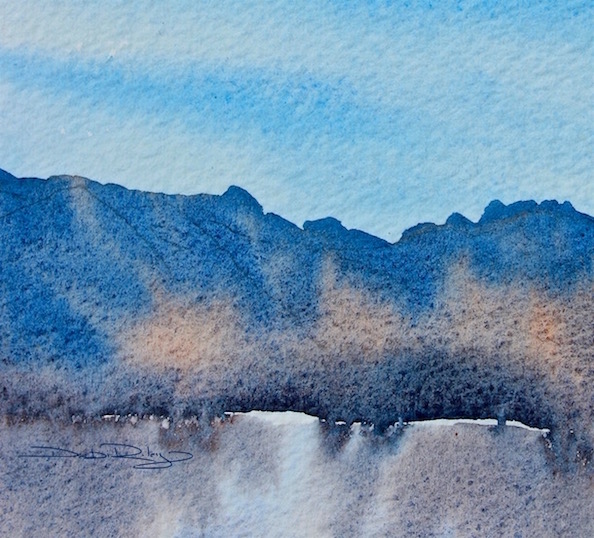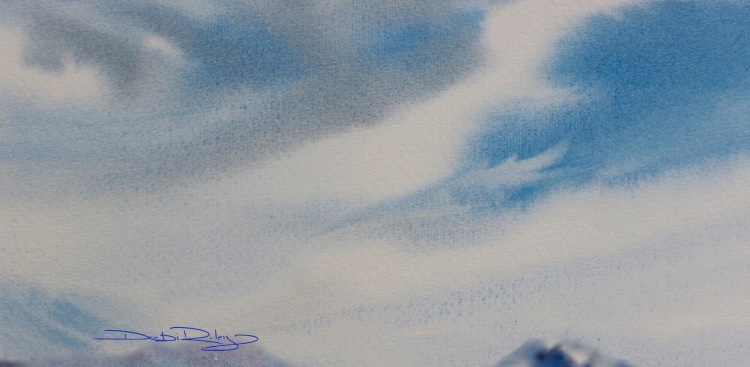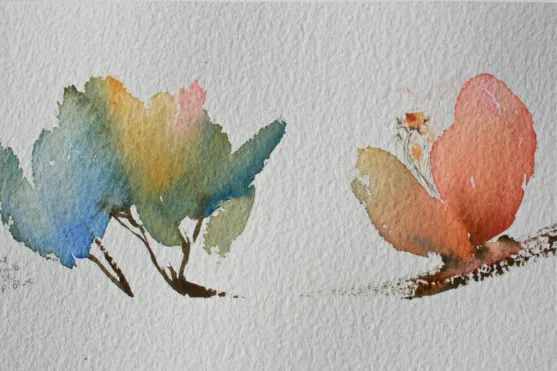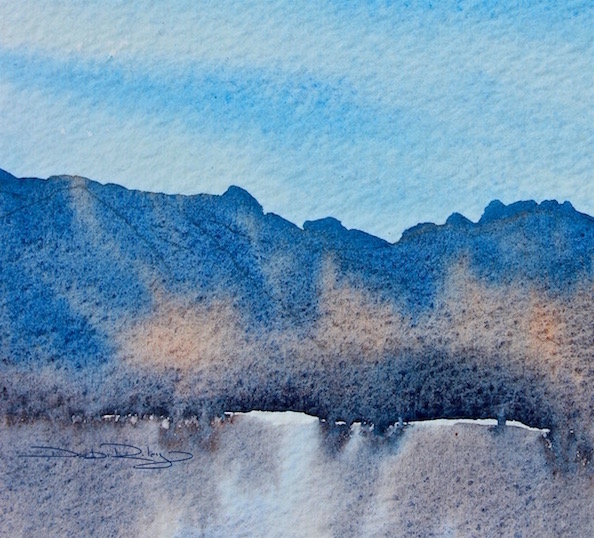Watercolor Techniques. So many and so confusing! What’s the difference between wet into wet and charging? Please explain!

“If you wish to master watercolor, you must First, become its disciple.” DJR
This mini beginners’ watercolor lesson on techniques, features two of my favorites: Wet into wet and Charging.
I’ve used Ultramarine Blue pb29 and Burnt Sienna PBr7 to create the mountains in the above image. That duo is an exceptionally, versatile combination for skies, hills, rocks, water, trees, pottery, people, animals.
Watercolor Basic Techniques
Two primary basic watercolor techniques I use are Charging and Wet into Wet.
They’re often mixed up. But, there is a difference in how, why and where each is used, and understanding those concepts makes things a whole lot easier for the beginner watercolorist.
Wet into Wet
Wet into wet is a fun watercolor technique that can help create additional depth and perspective in a beginner’s painting.
Most useful in creating the Backgrounds.

The process starts with wetting the good quality paper, Arches cold press works best for beginners to create the smoothness of the silky transitions desired.
The above example of a wet in wet sky, shows a lovely smooth transitition of color and tone.
There are no streaks, blotches or uneven patches. I would have those – had I used student quality paper.
100% cotton will give me smoothness, which equates to better results and then I’m much happier.
Wet into Wet watercolour technique
- The paper should be wet, not flooded. Definitely not too dry or patchy.
2. The brush needs to be fully loaded with paint, dripping with paint. Then just ‘kiss’ the brush tip to the paper’s uppermost surface…. allowing the paint to flow down and into the paper, without man handling the brush.
Try to avoid the urge to rub, scrub, force the paint into the paper; but merely, encourage it to flow into it.
Think of yourself as the Facilitator.
Often as I stand to paint, I hold the paper at an angle, so that “gravity” will help this process. It will.
Recession: Wet into wet creates Soft Blurred Edges.
Soft blurred edges are ideal for creating the illusion of depth and perspective found in the background, in the distance.
Also, perfect for skies.
Usually, with the wet into wet watercolor technique, I’m aiming to create tonal variations of Light, Mid and Dark tones. I won’t be too pleased with the consequences of just one tone. It will be too flat. Not enough depth or perspective.
Charging

Charging watercolor technique is probably the one I use the most. It gives me the most versatility as I am working on the watercolor painting.
I need to remember a crucial factor for Charging: the subsequent color to be added, needs to be less watery, than the preceding color put down.
By just a narrow ratio. Not so dry that it ‘sticks’ to the paper, because then the colors will not flow and melt together properly.
Charging differs from Wet into Wet in that with Charging, rather than being focused on the Background, the charging technique can really be applied to any shape. The shape of a cloud, a flower, a tree trunk, a leaf, shrubbery, etc.
Watercolor Charging Technique Process:
- lay a light palest wash down over the entire area of the shape first
- mix a medium tone and apply it into the pale wash starting at the base and going about 2/3 the way upwards
- do this immediately, while that first pale wash is still wet. Very…. Important.
- next, while all the above color is Still wet – get the final color in
- mix a very deep intense dark. apply it to the base and soften it upwards about 1/4 the way
- making sure that you have been fast enough, Very Important, to get the colors in so they can melt and merge together seamlessly
Each of these flower shapes, have been created through the use of the charging technique.

The goal is to create a smooth, even transition of colors plus Tone, going from the palest light tone on top, to the deepest dark at the bottom of the shape.
That’s the Goal, anyway.
It takes practice, several. Well, perhaps…. a dozen or so. Or more.
Wait….Stop sighing! Look on the Bright side. This is just a good excuse to paint More! Its fun.

Both have a nice transition of colors; Above is very smooth, the Below image is slightly rougher in the transition creating a more layered look.

Summary
- Generally speaking, watercolour’s wet in wet is great for creating soft edges for backgrounds.
- Wet in wet begins with clean water on the paper.
- Charging technique is useful for shapes to create a transition of color and tone that is silky smooth and subtle. But clear.
- Charging begins with a pale light wash and introducing MEDIUM tone next, into it.
A Glaze is different altogether. It needs Dry paper. Whereas the other two need Wet, the Glaze technique must have a perfectly dry paper to succeed. ie color is applied, left to dry, then another color is applied in a thin ‘sheer, see through, veil’ over the first color that is Dry. Very Dry. Heavy Emphasis on Dry. (hopefully, someone is smiling by now!)
More information, images and articles are available at Watercolour Tips page ( there are 6-7 posts with relevant info on Watercolor Techniques, examples. Glazing, dry brush, splatter, flat wash, etc. are discussed.
Also, check out my newly constructed art sites at Pinterest, pinterest.com/debijriley with amazing examples of inspiring and creative drawings, paintings, sculpture, printmaking and glass works.


Oh Debi! I am in AWE of your work! I love every one of these! Thank you for sharing the “charging” technique. thank you so much! I had not heard of that terminology yet. When adding the layers, do you do right away? I am thinking you do – but just checking. Is it called “glazing” if you leave each layer dry? So much to learn! Thank you thank you thank you! I still want you to come visit and teach me in person 🙂
LikeLiked by 1 person
well Miss Jodi, thank you! Good Questions you asked too. I revised my post to answer them! you on west coast btw or east? … anyway, thank you for asking these questions, this helps to answer alot of others queries as well, I’m sure! short answers, right away. dry. you will see, in the revised post. 🙂 cheers, debi
LikeLiked by 1 person
Thanks Debi! East coast.
LikeLiked by 1 person
most of my rellies are West coast, but flights are alot less in the US than OZ. Definitely!!
LikeLiked by 1 person
Thank you for revising the post sweet Debi! You clarified a lot for me, and I appreciate! And I’m smiling! Except – wish your rellies were on the East Coast!
LikeLiked by 1 person
you’re welcome Jodi! I’m quite glad you asked those questions. As I’m explaining, I’m sure I forget to include details 🙂
LikeLiked by 1 person
you are very generous in explaining! thank you!
LikeLiked by 1 person
it is my pleasure Jodi 🙂 and have a happy New Years Eve – you going to “Watch Me, nae nae” ? LOL
LikeLiked by 1 person
You betcha! But you get to do it first! 🙂 Happy New Year Debi!
LikeLiked by 1 person
watch me … yeah, watch me…. snoooze! LOL
LikeLiked by 1 person
I plan to write a post on Glazing Technique, (what, when, where, how, why) if you have specific questions on it, send me them, and I can be sure to answer them! Cheers, Debi
LikeLike
Stunning examples and wonderful tutorial, thanks Deb!
LikeLiked by 1 person
hey! Very glad you enjoyed this 🙂 excellent to hear! cheers, Debi
LikeLiked by 1 person
Another wonder class, thank you Debi. I appreciate your information about the charging technique Debi. Wonderful happy New Years gift. Thank you.
LikeLiked by 1 person
Thank You Sharon. just wish I could ‘Show’ this technique, as it is a trickier one… but I don’t have someone record for me.
LikeLiked by 1 person
That would be great if you could record, maybe the opportunity will happen this coming year.
LikeLiked by 1 person
This year, I will be more ‘open’ and active, about having a class lesson being recorded. Maybe a new student has the tech skills!
LikeLike
Lovely clear explanation of technique!
LikeLiked by 1 person
hi Kate, thank you so much for stopping by and your thoughtful, comment! I quite appreciate hearing how the post is faring and if there are any questions. Have a Happy New Year! Cheers, Debi
LikeLike
Great examples and perfect explanations too. I love your charged examples. You must be very organized, disciplined or both! happy new year!
LikeLiked by 1 person
L’Adelaide happy New Year to you! and Thank you kindly!! When I was younger I was both, rigidly organized and disciplined. The older I become….. well, life is to be lived, isn’t it!? LOL Still have the discipline, a bit less of the other. I have to admit, I LIKE Lists 🙂
LikeLike
I especially love the sunrise example, the light lining is totally beautiful – Happy New Year Debi!
LikeLiked by 1 person
good morning v, and happy New Year!! 2016 Hope you will have a wonderful NYE. Thank you for your lovely comment on Sunrise! I always am amazed at how apt “Less is More” really is. 2 colors. I guess its the which 2, and the when to….. LOL Thank you……. Cheers! Debi
LikeLiked by 1 person
You are SO Gifted, Debi!! My hands long to do what you do, but alas, it does not happen. So I dabble in my abstracts (pastels) just drawing anything that comes forth. I have to admit I do make some pretty interesting paintings. LOL ❤
LikeLiked by 1 person
good morning Amy! Thank you very much; had to smile, reading your comment. I think the same thing when I look at Monet, Sargent, Rothko paintings, lol I Love that you believe in yourself, in your own artistic vision!!! 🙂 yay!
LikeLiked by 1 person
Beautiful work! I have a busy work day ahead but looking forward to reading this in detail later, Debi! Thanks so much for sharing! Wow love that sky in the second image – truly amazing!
LikeLiked by 1 person
hi Laura, many thanks!! I was really partial to it as well…. til I mucked up the bottom bit. 😦 sigh. IT happens. But the bright side is, I gained quite a bit from doing it anyway. fun too!
LikeLiked by 1 person
I see no muck up! Glad you had fun, Debi!
LikeLiked by 1 person
laughing…. I had to crop the bottom off after I added a mountain that turned to a Blob!… LOL
LikeLiked by 1 person
Way to save the painting! Sky and mountain top look great!
LikeLiked by 1 person
lol….. i like cropping 🙂 thanks Laura!
LikeLiked by 1 person
wonderful paintings and very interesting words, as usual, Debi- By the way, in my stats you are Nr. 1 in comments. Thanks and have a fantastic, artistic, wonderful New Year, kind regards Mitza from the cold side of the world
LikeLiked by 1 person
Dear Mitza, throughout the past year, your comments and dialogue as I was Just Getting Started on WordPress, knowing -nada- has been a real blessing to me as well. Thank you 🙂 Debi
LikeLiked by 1 person
that’s really nice to hear, dear Debi. Let the wings of friendship never loose a feather, hehe, all the best for wordpress and 2016, kind regards Mitza
LikeLiked by 1 person
yes, same to you …+ happy cycling too!
LikeLiked by 1 person
hehe, already did 3 today
LikeLiked by 1 person
well, I worked too. hmm, What you ask? Eating! LOL
LikeLiked by 1 person
hehe
LikeLike
Another great piece for the Deb Riley art “bible”. Congrats on the pinterest site; beautifully done. Best wishes for a very happy new year and creative 2016 🙂
LikeLiked by 1 person
Andrew, you’re really very kind! Thank you again! HNY cheers, Debi
LikeLiked by 1 person
Great stuff, Deb Riley. Love your examples and your handling of the paint.
LikeLiked by 1 person
Many thanks Mary, I’m glad you liked the post and the images! I appreciate your lovely comment. cheers, Debi
LikeLiked by 1 person
Great informative post! Never knew creating blooms was called charging.
LikeLiked by 1 person
hi Eileen, thank you for your lovely comment! oops, I didn’t clarify properly about Charging Technique! it is Different.
A ‘bloom’ or ‘cauliflower’ happens by chance or purposely, when your brush is WETTER than the surrounding paint.
And there is no intent of trying to create a tonal gradation of Light, Mid, Dark.
Whereas with Charging – it is meant to be with successful, dryer brush load of paint in order to create the desired tonal gradation of Lighter, Mid, Darker at the base of the shape (perhaps a hill, cloud, petal, leaf.)
another example of charging is in my GALLERY, the painting “Simply A Bloom” this was also using a charging method. Thanks Eileen, I’m sure many others needed this clarified!! cheers, Debi
LikeLiked by 1 person
Thanks Debi for the explanation and I’ll check out the example.
LikeLiked by 1 person
HI Eileen, no worries! I’m always happy to share! 🙂 cheers, Debi
LikeLike